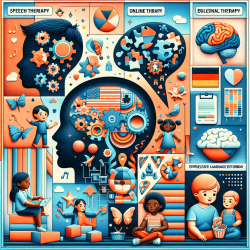In recent years, the intersection of cognitive-behavioral play therapy (CBPT) and bilingualism has gained considerable attention in the realm of speech-language pathology. A study titled The Effect of Cognitive–Behavioral Play Therapy on Improvements in Expressive Linguistic Disorders of Bilingual Children offers valuable insights into how CBPT can significantly improve expressive language disorders in bilingual children. This blog aims to explore the findings of this research and provide practical recommendations for practitioners looking to enhance their therapeutic approaches.
Understanding the Research
The study conducted by Rezaeerezvan, Kareshki, and Pakdaman (2022) involved 60 bilingual preschool children with expressive language disorders. These children were divided into three groups: experimental, control, and pseudo-control. The experimental group underwent 12 sessions of CBPT, each lasting 90 minutes. The control group received no intervention, while the pseudo-control group received non-play therapy training.
The study utilized the Wechsler Intelligence Scale for Children (WISC-IV) and the Test of Language Development (TOLD-P: 3) to assess the children's language skills before and after the intervention. Data analysis using ANCOVA revealed that the experimental group showed significant improvements in expressive language skills compared to the control and pseudo-control groups.
Key Findings
- CBPT significantly improved the expressive language disorders of bilingual children.
- The experimental group showed a notable decrease in expressive language disorder scores from pretest to posttest and follow-up stages.
- Statistical analyses confirmed the effectiveness of CBPT, with a significant effect size (Eta-squared) indicating that 98.2% of changes in expressive language disorders were due to the intervention.
Practical Recommendations for Practitioners
Based on the research findings, here are some actionable steps practitioners can take to implement CBPT effectively:
- Tailor Sessions to Individual Needs: Each child is unique, and their therapy should reflect this. Customize CBPT sessions to address specific language deficits and cognitive-behavioral needs.
- Incorporate a Variety of Activities: Use storytelling, puppet shows, role-playing, and other interactive activities to engage children and enhance their expressive language skills.
- Focus on Emotional and Cognitive Aspects: Address both the emotional and cognitive dimensions of language disorders. Teach children to identify and manage their emotions while improving their language skills.
- Continuous Monitoring and Follow-Up: Regularly assess the child's progress and make necessary adjustments to the therapy plan. Follow-up sessions are crucial to ensure long-term effectiveness.
Encouraging Further Research
While this study provides compelling evidence for the efficacy of CBPT, more research is needed to explore its broader applications. Future studies could investigate the impact of CBPT on other psychological variables, such as self-esteem and social skills, and its effectiveness in different cultural contexts.
To read the original research paper, please follow this link: The Effect of Cognitive–Behavioral Play Therapy on Improvements in Expressive Linguistic Disorders of Bilingual Children.










